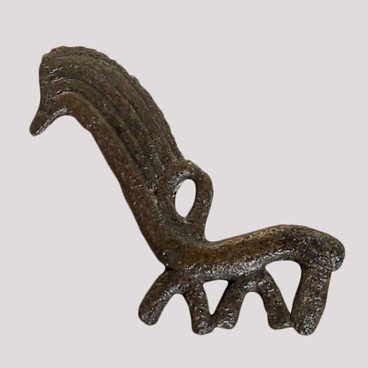Carolingian swords of the 9-10th centuries are steady and comfortable steel swords, the favorite weapon of the early medieval military aristocracy. The Carolingian sword was double-edged, about 1000 millimeters long, with a deep fuller and a short handle. Swords were supplied from European countries, primarily from the Frankish state. A considerable part of them were made in Scandinavia itself, often copying and developing imported drafts. The quality of imported Frankish swords was much higher than similar Scandinavian ones — the carbon content of the steel of Norwegian swords is significantly lower. Carolingian blades were worth a fortune: in the 10th century, one sword could pay a thousand silver coins. Such weapons could be afforded only by princes, governors, the most respected and wealthy warriors. Ordinary warriors used spears, bows and axes. Carolingian swords are especially rare and significant finds.
In 1950, during the excavation of mound No. 2 of the central group of mounds of the Gnezdovo archaeological complex, an expedition led by Professor Avdusin found a sword of the Carolingian type. Perhaps the sword was made directly in the Gnezdovo settlement by local craftsmen. The length of the sword is 930 mm, the length of the guard is 130 mm, the width of the blade is 50 mm. The sword is dated to the middle of the 10th century.
According to the Norwegian historian Peterson, who proposed a typology of swords, this find belongs to type ‘D’. The handles of swords of this type have a crosshair and a pommel, consisting of a base and a semicircular head, clearly divided into three parts. A distinctive feature of these swords is the intricate decorative ornamentation. Such an ornament is typical only for decorating women’s items. This placement of the “female” ornament on a purely “male” item made it possible to interpret the sword handle as a kind of “hybrid” created among the Scandinavian settlers gradually assimilating in Russia.
To date, 24 swords have been found on the territory of the Gnezdovo archaeological complex.
In 1950, during the excavation of mound No. 2 of the central group of mounds of the Gnezdovo archaeological complex, an expedition led by Professor Avdusin found a sword of the Carolingian type. Perhaps the sword was made directly in the Gnezdovo settlement by local craftsmen. The length of the sword is 930 mm, the length of the guard is 130 mm, the width of the blade is 50 mm. The sword is dated to the middle of the 10th century.
According to the Norwegian historian Peterson, who proposed a typology of swords, this find belongs to type ‘D’. The handles of swords of this type have a crosshair and a pommel, consisting of a base and a semicircular head, clearly divided into three parts. A distinctive feature of these swords is the intricate decorative ornamentation. Such an ornament is typical only for decorating women’s items. This placement of the “female” ornament on a purely “male” item made it possible to interpret the sword handle as a kind of “hybrid” created among the Scandinavian settlers gradually assimilating in Russia.
To date, 24 swords have been found on the territory of the Gnezdovo archaeological complex.



